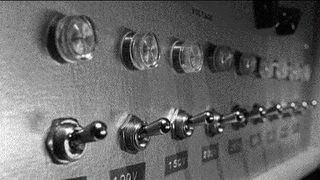Wednesday, May 18, 2005
The Milgram Experiment

Okay, so this is from your Psychology 101 class:
In 1961, Dr. Stanley Milgram sets up a mock "experiment in memory." Two subjects are brought in, though one is actually an actor. The actor is hooked up to an electric shocking machine, and the real subject is told to shock him until the correct answer to a memory question is given. In many cases, the subject actually shocked the actor "to death." Most people have heard of this in one form or another.
So, Steve Elliott and I went to see Enron: The Smartest Guys in the Room the other night. (Great movie) There were references to the Milgram Experiment, plus some rare footage, and it was really frightening. The statistics were that 60% of the subjects actually shocked the "learners" to death.
I wanted to know more about this. Not just the general, but the specifics. And who had the best explanation? Good ol' Wikipedia, that's who.
My observations on their explanation:
Teacher = Person administering the shocks (the subject, i.e. the real person);
Learner = actor receiving the fake shocks
-- The teacher was given an initial 45volt shock, so they would know what it felt like.
-- Not clear if teachers were informed that the 450volt equaled death, but that's when the experiment stops.
-- In the initial study, and the many, many studies that followed a consistent 61-66% of people administered the 450volt shock.
-- The Learner did not actually scream. Instead he would push a button that emitted a pre-recorded scream, relevant to each level of voltage. At some point he would bang on the wall and complain about his heart ailment, which he'd mentioned earlier to the teacher.
-- The volts increased by 15 volts. Presumably, this means that there were 27 shocks administered from start to finish.
-- No teacher stopped before 300 volts were administered. So, even if some people refused to kill, all the teachers still shocked the heck out of people
-- Milgram saw the conformity aspect different from the authority aspect. Or, at least he measured it differently. In the conformity experiment, he added two additional "teachers" (both actors) who could agree or disagree that the experiment would continue. In the 40 cases when both teacher-actors agreed that the experiments should continue, only 3 of the real people refused to shock anymore. Surprisingly, out of the 40 cases when both teacher-actors agreed that the experiments should stop, 4 of the real people actually continued on to the 450volt. Or, maybe this is not surprising.
-- Finally, this all began in 1961. I wonder if the rate would be different now. The experiment was pre-Watergate, pre-Vietnam War. On the other hand, it is post-911. If the rate is not changed, keep in mind that 3 of 5 people would kill another person for a minor violation of a memory experiment, simply because an authority figure told them "The experiment must continue" and "I'll take responsibility for this."

posted by Anonymous at 12:03 PM